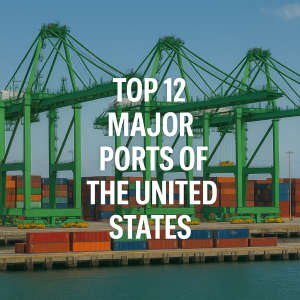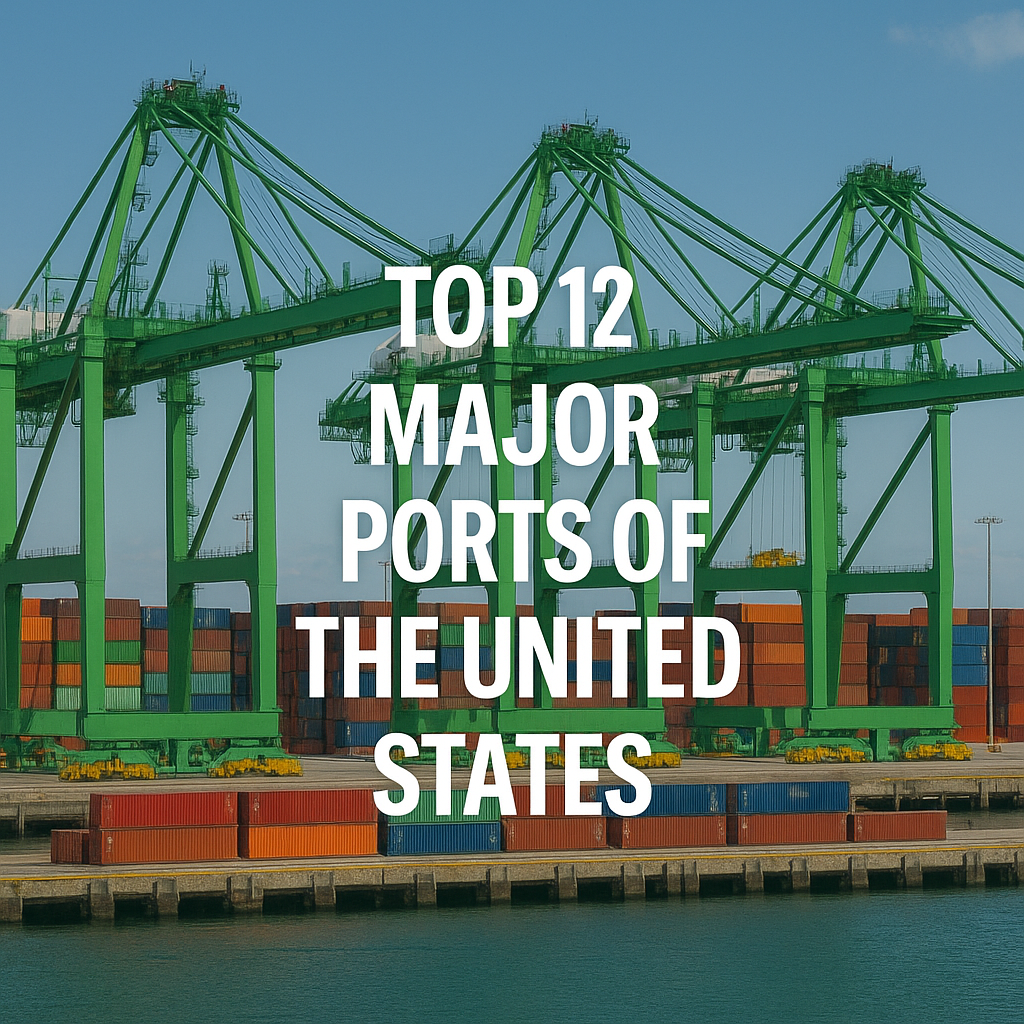Discover the top 12 major ports of the United States that drive trade, logistics, and economic growth. Learn about their infrastructure, cargo volumes, and technological advancements in this comprehensive guide.
Why U.S. Ports Matter in Modern Maritime Operations
The United States is home to some of the most critical seaports in the world, serving as the backbone of its trade economy. More than 90% of the nation’s overseas trade is conducted by sea, and U.S. ports handle over 2.3 billion metric tons of cargo annually (U.S. Maritime Administration, 2023). These ports facilitate the movement of everything from electronics and vehicles to agricultural products and crude oil, supporting more than 30 million jobs and contributing trillions of dollars to the national GDP.
In a global economy increasingly shaped by digitalization, environmental regulation, and supply chain resilience, understanding the role of major U.S. ports is vital for maritime professionals, policymakers, and educators.

1. Port of Los Angeles (California)
- 2023 Cargo Volume: Over 180 million metric tons
- Known For: Largest port in the U.S. by container throughput
- Highlights: Advanced automation, Port Optimizer digital platform, environmental initiatives
Website: https://www.portoflosangeles.org
2. Port of Long Beach (California)
- 2023 Cargo Volume: 175 million metric tons
- Significance: Second-busiest container port in the U.S.
- Strengths: Green Port Policy, zero-emission terminal development, smart freight systems
Website: https://www.polb.com
3. Port of Houston (Texas)
- 2023 Cargo Volume: 285 million metric tons
- Focus: Energy exports, petrochemicals, and containers
- Notable: Largest port on the Gulf Coast; Houston Ship Channel expansion
Website: https://porthouston.com
4. Port of New York and New Jersey
- 2023 Cargo Volume: Approx. 135 million metric tons
- Unique Aspects: Largest East Coast port, extensive intermodal rail connections
- Innovation: Raised Bayonne Bridge for mega-ships, ExpressRail network
Website: https://www.panynj.gov
5. Port of Savannah (Georgia)
- 2023 Cargo Volume: Over 120 million metric tons
- Positioning: Fast-growing logistics hub in the Southeast
- Projects: Savannah Harbor Expansion Project (SHEP), inland port systems
Website: https://gaports.com
6. Port of Seattle-Tacoma (Washington)
- 2023 Cargo Volume: Over 100 million metric tons
- Identity: Managed by the Northwest Seaport Alliance
- Advancements: Shore power, clean truck programs, smart gate tech
Website: https://www.nwseaportalliance.com
7. Port of Oakland (California)
- 2023 Cargo Volume: 70 million metric tons
- Specialty: Strong export orientation, especially agricultural products
- Development: Middle Harbor terminal modernization, Cool Port logistics center
Website: https://www.portofoakland.com
8. Port of Virginia (Norfolk)
- 2023 Cargo Volume: 65 million metric tons
- Highlights: Fully automated terminal, deep harbor, global reach
- Sustainability: Electrified cranes, carbon-cutting initiatives
Website: https://www.portofvirginia.com
9. Port of Charleston (South Carolina)
- 2023 Cargo Volume: 62 million metric tons
- Reputation: Fast container turnarounds and state investment
- Investments: Hugh K. Leatherman Terminal, inland port network
Website: https://scspa.com
10. Port of Miami (Florida)
- 2023 Cargo Volume: 53 million metric tons
- Dual Role: Major cargo and cruise terminal
- Modernization: Deep dredge projects, on-dock rail enhancements
Website: https://www.miamidade.gov/portmiami
11. Port of Baltimore (Maryland)
- 2023 Cargo Volume: 50 million metric tons
- Specialization: Roll-on/roll-off cargo, forest products
- Growth: Howard Street Tunnel reconstruction for double-stack rail cars
Website: https://mpa.maryland.gov
12. Port of Corpus Christi (Texas)
- 2023 Cargo Volume: Over 240 million metric tons
- Focus: Oil and gas exports, breakbulk cargo
- Edge: Largest crude oil export port in the U.S.
Website: https://portofcc.com
Real-World Applications: Case Studies in Port Operations
Port of Houston: Energy Corridor to the World
The Port of Houston plays a crucial role in U.S. energy exports. Its location and infrastructure support a global supply chain for refined products, LNG, and petrochemicals. Recent expansions have improved draft depth and vessel capacity to accommodate VLCCs (Very Large Crude Carriers).
Port of Savannah: The Inland Empire
By establishing inland ports in Georgia and South Carolina, the Port of Savannah has significantly reduced congestion and improved rail access for shippers across the Southeast. Its rapid growth makes it a template for mid-sized port expansion.
Port of Virginia: Leading Automation
Norfolk International Terminals feature automated stacking cranes and remote-controlled operations. This efficiency has led to reduced container dwell time and increased safety.
FAQs
1. What makes a port “major” in the U.S.? Major ports are defined by cargo volume, infrastructure, global connectivity, and intermodal capacity. Metrics include total tonnage, TEUs, and vessel calls.
2. Which U.S. port is the busiest? By total tonnage, the Port of Houston leads. By container throughput, it is the Port of Los Angeles.
3. Are these ports connected by rail? Yes. Many major ports have integrated intermodal systems, connecting to national rail networks like CSX and Union Pacific.
4. What’s the role of sustainability in U.S. port operations? Ports are increasingly adopting zero-emission equipment, shore power, and renewable energy under guidance from MARAD and local regulations.
5. How are ports funded? Ports are typically funded through a combination of user fees, federal grants (e.g., INFRA and PIDP), and public-private partnerships.
6. What are some challenges facing U.S. ports? Labor shortages, climate change, congestion, aging infrastructure, and cybersecurity are major ongoing challenges.
7. How are ports adapting to global shipping trends? Through automation, dredging projects for larger ships, digital twin technologies, and improved data sharing for real-time logistics coordination.
Conclusion
The top 12 major ports of the United States are more than cargo handling facilities—they are engines of commerce, innovation, and infrastructure modernization. As global shipping continues to evolve, these ports are investing in smarter, greener, and more resilient solutions.
From the energy corridors of Texas to the logistics hubs of the Southeast, each port plays a unique role in supporting U.S. trade competitiveness.
Call to Action: For maritime professionals, researchers, and students, staying informed on port developments is crucial. Explore port authority reports, attend maritime conferences, and follow MARAD updates to remain at the helm of maritime progress.
References
- U.S. Maritime Administration (MARAD). (2023). Port Statistics and Infrastructure Programs. https://www.maritime.dot.gov
- Port Authorities (Various). Annual Reports and Expansion Plans
- American Association of Port Authorities (AAPA). (2023). Economic Impact of U.S. Ports. https://www.aapa-ports.org
- Lloyd’s List Intelligence. (2023). Port Rankings and Trade Metrics. https://lloydslist.maritimeintelligence.informa.com
- DNV. (2023). Port Sustainability Trends. https://www.dnv.com


Your method of explaining everything in this article is genuinely good, all be
capable of simply be aware of it, Thanks a
lot.